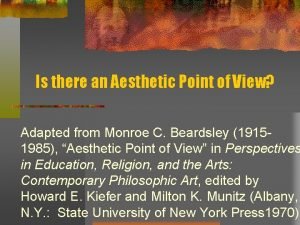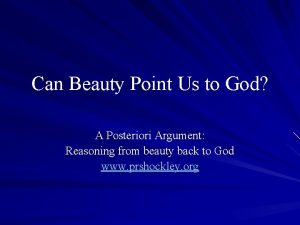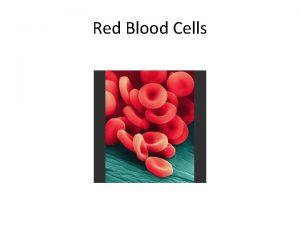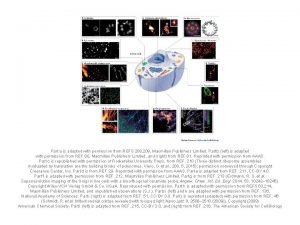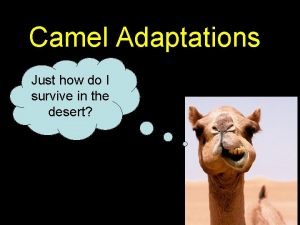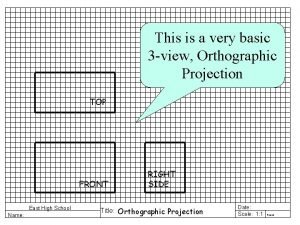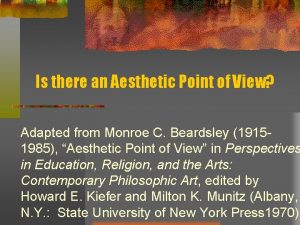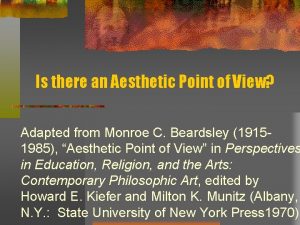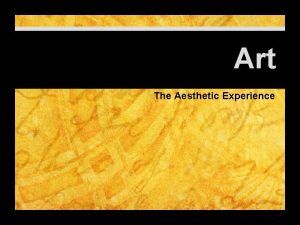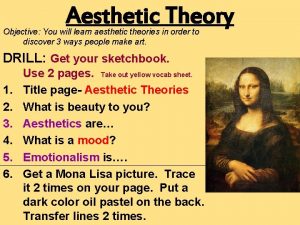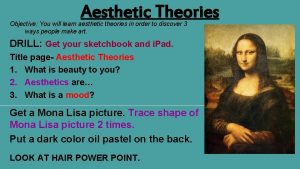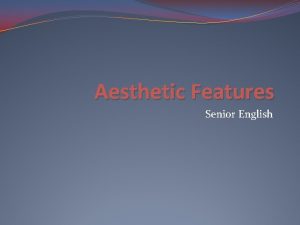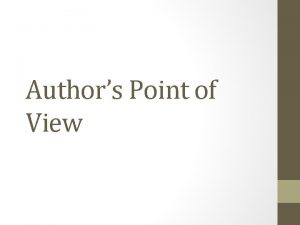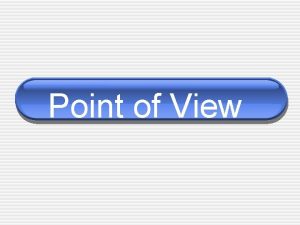Is there an Aesthetic Point of View Adapted


















- Slides: 18

Is there an Aesthetic Point of View? Adapted from Monroe C. Beardsley (19151985), “Aesthetic Point of View” in Perspectives in Education, Religion, and the Arts: Contemporary Philosophic Art, edited by Howard E. Kiefer and Milton K. Munitz (Albany, N. Y. : State University of New York Press 1970).

Summary of Paper: Section I. While we cannot deny there is something peculiarly aesthetic to be found in our world of experience, whether we can pin down exactly what that something is remains questionable. Thus, Beardsley proceeds to try to pin down the concepts inherent in the aesthetic.

Summary of Paper: Section 2: Whenever we regard anything, be it art or not, we can try to understand the object from varying points of view. Since there is often conflict when trying to evaluate whether object x is good, Beardsley’s first position, is that, philosophically, we need to understand what point of view we are using in order to avoid disputes. Thus, we need to understand what other points of view might be in play.

What is peculiarly aesthetic? The effort to discover the uniquely aesthetic aspect, component, or ingredient in whatever is or is experienced has been considered greatly, thus giving evidence that there is something is peculiarly aesthetic (pg. 219): Aesthetic experience Aesthetic value Aesthetic enjoyment Aesthetic satisfaction Aesthetic objects Aesthetic situations But what is the nature of aesthetics has been elusive, widely debated, and surprisingly

To understand an Aesthetic Point of View: If the notion of the aesthetic point of view can be made clear, it should be useful from the philosophical point of view: 1 st: To understand a particular point of view, we must envision its alternatives. • Eg. , a well-building has three conditions: commodity (architectural; practical), firmness (engineering), and delight (experience).

An aesthetic point of view could be in terns of being “good of a kind. ” (e. g. , building. The kind is architecture, the good is focusing on whether it is a good work of architecture). a. We judge it in relation to its kind. But the “point of view” terminology is more elastic than the “good of its kind” terminology. To consider a bridge or music or sculpture as an aesthetic object is to consider it from the aesthetic point of view but what about a mountain, sea shell, or a tiger? But if A sea shell can’t be good sculpture if it is not sculpture

What about the installation of an “invisible sculpture” behind the Metropolitan Museum of Art? The installation consisted in digging a grave-size hole and filling it in again. Sam Green’s comments are interesting (he is N. Y. city’s architectural consultant): “This is a conceptual work of art and is as much valid as something you can actually see. Everything is art if it is chosen by the artist to be art. You can say it is good art or bad art, but you can’t say it isn’t art. Just because you can’t see a statue

2 nd Philosophical use of the notion of the aesthetic point of view is to provide a broad concept of art that might be helpful for certain purposes: “A work of art (in the broad sense) is any perceptual or intentional object that is deliberately regarded from the aesthetic point of view. ” “Regarding” would include “looking”, “listening”, “reading”, and other similar acts of attention, and “exhibiting”-picking up an object and placing it where it readily permits such attention, or presenting the object to persons acting as spectators (pg. 222).

What then is the aesthetic point of view (pp. 222 -23). “To adopt the aesthetic point of view with regard to X is to take an interest in whatever aesthetic value X may possess” (pg. 222). Rather, a broader definition for Beardsley may be better: “To adopt an aesthetic point of view with regard to X is to take an interest in whatever aesthetic value that X may possess or that is obtainable by means of X”

To adopt an aesthetic point of view would include the following: a. Judging (estimate value of X) by appealing to certain canons of reasoning, rules of evidence. But which are the aesthetic rules of evidence? a. Provides aesthetic gratification which other kinds of values do not.

“Gratification is aesthetic when it is obtained primarily from attention to the formal unity and/or the regional qualities of a complex whole, and when its magnitude is a function of the degree of formal unity and/or the intensity of regional quality” (pg. 225). The above definition is substantiated by the following statement: “The amount of aesthetic value possessed by an object is a function of the degree of aesthetic gratification it is capable of providing in a particular experience of it. ” a. What a work does provide, it clearly can

Three difficulties that have been raised against the capacity-definition of aesthetic value (pp. 226 -235): 1. Unrecognized masterpiece problem, i. e. , the problem of falsification (jewels buried in the ground); 2. LSD problem; i. e. , the problem of illusion; 3. Edgar Rice Burroughs problem; i. e. , the problem of devaluation. Devaluation is due to the shift in our value grades caused by enlargement of our range of experience; we can overestimate the aesthetic gratification of X; 4. Also have the range of aesthetic value to consider: Some take it too widely (e. g. , art is a junkyard) and others too possibly too narrowly (should we consider The Deputy by Rolf

“What does follow is that there is a certain asymmetry between negative and affirmative judgments, with respect to the degree of confirmation; but this is so between negative and affirmative existential statements in general. The experienced critic may have good reason in many cases not only for confessing that he finds little value in a painting, but for adding that very probably no one ever will find great value in it” (pg. 227). ” (2) If aesthetic value involves capacity, then its presence can no doubt be sufficiently attested by a single realization. What a work does provide, it can

Given the difficulties mentioned, like the LSD and devaluation problem, it may prove worthwhile to modify the earlier definition: “The aesthetic value of X is the value that X possesses in virtue of its capacity to provide aesthetic gratification when correctly experienced” (pg. 228). Be a reliable or dependable source of gratification and a repeatable experience. But there are time when we see object X only once. Are they reliable? They certainly could be.

“The aesthetic value of X is the value that X possesses in virtue of its capacity to provide aesthetic gratification when correctly and completely experienced. But we need to acknowledge as well there are is the possibility that there may be situations in which it is morally objectionable to adopt the aesthetic point of view (e. g. , The Deputy by Roth Hochmuth’s play) (pg. 234).

Conclusion is two-fold: A. There are occasions on which it would be wrong to adopt the aesthetic point of view because there is a conflict of values and the values that are in peril are, in that particular case, clearly higher (235 -6): (e. g. , taking pictures of a murder while it is taking place or assisting the victim, ending the potential crime). B. There is nothing-no object or event- that is per se wrong to consider from the aesthetic point of view. This, I think is part of the truth in the art-for-art’ssake doctrine. To adopt this view is simply to seek out a source of value. There can be no moral error

Objections: Gratification is very psychological. The sensitivity you gain fosters greater awareness which may foster greater pain. Aesthetic point of view is divorced from other disciplines of thought (e. g. , Can we really say Mein Kampf is beautiful because of rhetoric even though the moral aim is horrific? ). How do we know this is the correct criteria? How do we define “formal unity, intensity, and complexity? ” He needs to provide examples that satisfy this condition. The problem of perception. His emphasis on gratification fosters skepticism for how do you know that the unity, intensity, and complexity is occurring in the mind? Thus, why do you even want to talk to the object because you are now concerned with the content of your consciousness.

Objections: He begins with a point of view being aesthetic value. Then it goes to aesthetic gratification. Gratification seems to be about pleasure. He is not different than Hume, Kant, etc we are talking about a subject effect from an outside world.
 Aesthetic point
Aesthetic point Beauty point aesthetic
Beauty point aesthetic This passage is adapted from jane austen
This passage is adapted from jane austen Red blood cells are
Red blood cells are Adapted with permission from
Adapted with permission from In what ways have the highland maya adapted to modern life?
In what ways have the highland maya adapted to modern life? Xerophyte adaptations
Xerophyte adaptations Chaparral biome climate
Chaparral biome climate Camel structural adaptations
Camel structural adaptations Adapted animals in the rainforest
Adapted animals in the rainforest The two brothers adapted
The two brothers adapted Adapted from the internet
Adapted from the internet How is amoeba adapted for gas exchange bbc bitesize
How is amoeba adapted for gas exchange bbc bitesize How have plants adapted to the rainforest
How have plants adapted to the rainforest How spermopsida adapted to life on land
How spermopsida adapted to life on land The outsiders adapted for struggling readers
The outsiders adapted for struggling readers Highlighted synoynm
Highlighted synoynm How are giraffes long necks adapted to their lifestyle
How are giraffes long necks adapted to their lifestyle The orthographic view drawn directly above the front view.
The orthographic view drawn directly above the front view.
